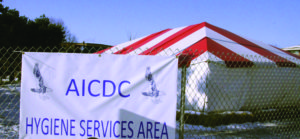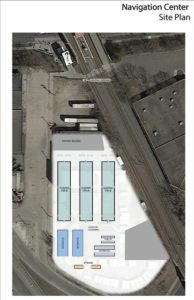Franklin/Hiawatha Encampment respite ready

TESHA M. CHRISTENEN
Workers put the finishing touches on the Navigation Center in mid December 2018 so that those experiencing homelessness will have safe and secure, low-barrier housing at 2109 S. Cedar Ave.
by CAMLLE GAGE and MARGARET KING, COURTESY OF METROPOLITAN URBAN INDIAN DIRECTORS
If you”'ve been following the situation at the Franklin Hiawatha homeless encampment, you”'ve probably heard of the new “Navigation Center” being created by the city of Minneapolis and a variety of government and other partners.Â
After months of waiting, information about the center is now available to share. Here is a list of frequently asked questions about the center, which will provide safe and secure shelter for the homeless residents of the Franklin Hiawatha encampment.Â
Thanks to Margaret King, the city of Minneapolis Navigation Center project coordinator, for helping to compile these answers.
What is the Navigation Center and when will it open?
The center is a low barrier 24/7 access shelter designed for people living in the Franklin Hiawatha encampment. It will provide a calm, clean, safe environment with access to intensive support services. The center is scheduled to open in mid-December.
Who came up with the idea?
The Navigation Center concept is being used in a variety of cities across the country who are experiencing large numbers of homeless residents. It is often considered an emergency or transitional solution – to house people as they wait for more traditional shelter, GRH or Section 8 housing, or other affordable housing options.
What does ”˜low barrier”' mean?
It means that many of the barriers people face going to traditional shelters are eliminated or minimized.Â
People can come with their pets, partners and (adult) family members, and can opt to sleep near one another. There will be ample storage for personal belongings. There will be a strong harm reduction orientation.Â
The center will be open 24/7 and will not have a curfew.Â
People do not have to be sober. People who use drugs or alcohol will be welcome and will have access to different kinds of practical supports designed to help them stabilize and reduce the harms associated with substance use. Medication assisted treatment will be available on-site.Â
Violence and highly disruptive behavior will not be tolerated, but other than that there are as few rules as possible.Â
Families with minor children will not be housed at the Navigation Center, but other options are available for those with children.
What are the sleeping areas like?

TeshA M. Christensen
Information about the Navigation Center is available in the warming tent accross Franklin Ave. from the encampment.
The center will have three large heated tents that each have approximately 40 beds. Each bed will have a locking storage locker that fits underneath it. The tents will have a mixture of sleeping cots and gathering spaces with tables and chairs.Â
The guests staying in the center will have some freedom to design the placement of beds to create a livable and personalized space.
What services will be there?
The center will be open 24/7 and have spaces for gathering in large and small groups, meals, showers, and close access to services. Livio, a mobile health care services provider, will be on-site providing health care. Native American Community Clinic will be on-site with a suboxone clinic, Metropolitan Urban Indian Directors group and other agencies will have staff on-site on a regular basis and Native healing practitioners will be available.Â
Various other housing and service agencies will also be on-site regularly to serve the center”'s guests.Â
The intention is to provide intensive support to people so they can stabilize, set self-determined goals for the future, and gain access to the warmkind of long term housing that best serves their needs.
 What will happen to the current encampment when the Navigation Center opens?
What will happen to the current encampment when the Navigation Center opens?
Out of concern for the well being of the residents of the encampment, city and state officials have allowed the current camp to remain in place and have provided various supports to minimize public health and safety risks while the Navigation Center is being built.Â
However the intention to close the current encampment once the center opens has always been clear.Â
How and when the closure will happen is still under consideration, but at some point the current encampment will close.
How does a camp resident learn more about the Navigation Center and sign up for a bed there?
There will be an information table for the Navigation Center at the warming tent across Franklin Ave. from the encampment. The Navigation Center will be able to shelter 120 individuals and current camp residents are encouraged to visit the HSA tent and learn more.
The center is located on land temporarily provided for this purpose by the Red Lake Band of Chippewa on site that previously was Ambles Hardware and Machinery. It is across from Cedar Box Company and adjacent to the Franklin Light Rail Station and Takoda Institute ”“ American Indian Opportunities Industrialization Center at 2109 Cedar Ave. S.









